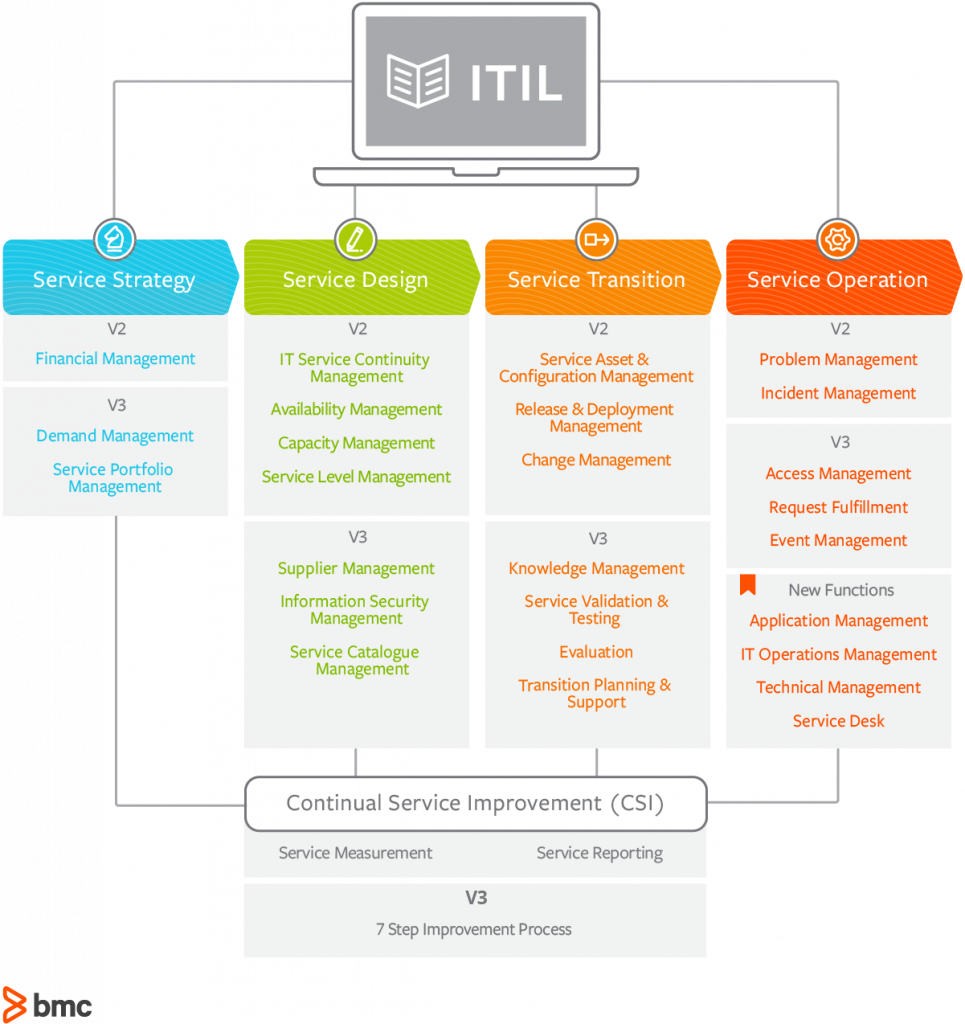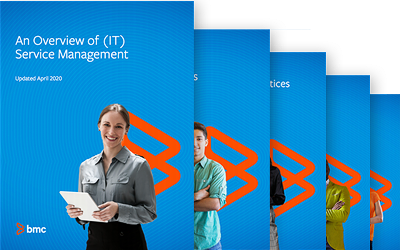ITIL stands for Information Technology Infrastructure Library. It is a set of proven IT processes and common practices for IT Service Management (ITSM). ITIL V2 and ITIL V3 are standards in the field of ITSM. V3 builds on the operational excellence concepts of V2, and boosts service management towards a more holistic approach.
Download Now: ITIL 4 Best Practice e-Books
These all-new for 2020 ITIL e-books highlight important elements of ITIL 4 best practices. Quickly understand key changes and actionable concepts, written by ITIL 4 contributors.
ITIL V3 services and processes

Key differences between V2 and V3 versions
| ITIL V2 | ITIL V3 |
|---|---|
| Heavily process-oriented | More service-oriented (Lifecycle approach to service management) |
| More about linear process flow from business to infrastructure | Offers a hub-and-spoke structure that adds flexibility |
| Includes around 700 pages of key publications | Includes around 1,400 pages in 5 key publications of service lifecycle (service strategy, service design, service transition, service operation, and continual service improvement) |
| Positioned around support and delivery of IT Services | Focuses on the full lifecycle of services, covering the entire IT firm |
| Offers little help to ITSM people to clearly articulate the benefits of professional service management | Clearly defines the roles and responsibilities, and reasons the role of communication in the entire lifecycle |
| Aims towards the “What” question—suggesting “What should be done to improve processes” | Takes care of the “How” question—explaining “How we should go about doing it” |
Let’s explore the differences in each phase
- Service strategy
The service strategy volume offers guidance on the design, development and implementation of service management.- Service portfolio management
ITIL V2 discusses service level management. Service portfolio management is a new concept in V3. V3 introduces strategic thinking about how the service portfolio should be developed in the future. - Demand management
ITIL V2 discusses demand management concepts within the context of capacity management. V3 introduces the process of demand management as a distinct process and as a strategic component of service management. - Financial management
Activities of financial management are similar in both ITIL V2 and V3. However, in ITIL V2, financial management was part of service delivery.
- Service portfolio management
- Service design
Service design provides guidance for the design and development of services.- Service catalogue management
In ITIL V2, the service level management process has mentioned the concept of a service catalogue. But there was no process outlined for its creation and maintenance. V3 introduces a dedicated process to make sure that the service catalogue is up to date and contains reliable information. - Information security management
ITIL V2 provides guidance on information security management in a separate book. In V3, security management is a part of service design. - Supplier management
In ITIL V2, supplier management was covered under ICT infrastructure management. In V3, it is part of the service design process. - Service level management
No differences between V2 and V3. - Capacity management
No differences between V2 and V3. - Availability management
No differences between V2 and V3. - IT service continuity management
No differences between V2 and V3.
- Service catalogue management
- Service transition
Service transition builds and deploys new or modified services.- Transition planning and support
V2 covers few aspects of this process under release management, but V3 offers considerably enhanced guidance. Transition planning and support in V3 is all about managing transition projects. - Evaluation
In ITIL V2, evaluation was discussed implicitly as part of various processes. In V3, evaluation has been made a process itself. - Service validation and testing
ITIL V2 covered some aspects of release testing under release management; V3 provides significantly enhanced guidance. - Knowledge management
Many knowledge management aspects were covered in ITIL V2. In V3, it has been added as a new independent process that provides knowledge to all ITSM processes. - Change management
The activities are identical in V2 and V3. - Release and deployment management
The activities in V3 are similar to those in V2. - Service asset and configuration management
No differences between V2 and V3.
- Transition planning and support
- Service operation
Service operation embodies practices in the management of service operations.- Event management
In ITIL V2, event management was covered under incident management. ITIL V3 sees event management as an important trigger of the incident and problem management processes. Hence it has been made a standalone process for detecting and managing events and alarms. - Request fulfillment
In ITIL V2, this process was covered under incident management, and in V3, it is added as a new process. - Access management
Access management was added as a new process to ITIL V3—as a consequence of IT security concerns. - Incident management
No differences between V2 and V3. - Problem management
Activities of this process are identical in V2 and V3. - Technical management
Technical management is a new function added to ITIL V3. The role of the technical management function is to provide technical expertise and overall management of the IT infrastructure. - IT operations management
This is a new function added to ITIL V3. Its focus is on the day-to-day, short-term activities required to operate and support IT services. - Application management
Application management is a new function added to ITIL V3—to support and maintain operational applications that support an organization’s business processes. - Service desk
No differences between ITIL V2 and V3—includes descriptions of all types, best practices, and roles and responsibilities related to a service desk.
- Event management
- Continual Service Improvement (CSI)
The CSI combines principles, practices and methods from quality management, change management and capability improvement.- Service measurement and service reporting
In ITIL V2, these processes were described under service level management process. V3 introduces dedicated processes for service and process evaluation. It expands this into CSI, and structures a 7 step process as listed below:- Define what you can measure
- Define what you should measure
- Gather the data
- Process the data
- Analyze the data
- Present and use the data
- Implement the corrective action
- Service measurement and service reporting
Summary
ITIL V3 offers a framework and an opportunity to unify and integrate IT groups to work together. This version contains useful insights from the latest business research and management theory, and incorporates strategic, innovation-focused and integrated view of service management.
Additional Resources
Original reference image:








